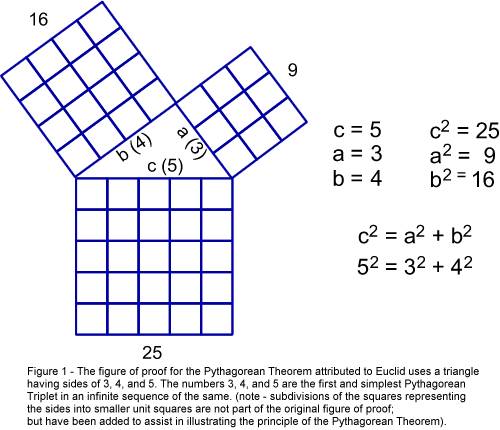|
Numbers
appear with astounding regularity in Masonic Ritual and within nature. It was
the revelation that numbers may be used to describe and even predict phenomena
found in the physical universe which prompted the Pythagoreans to develop their
system of Theosophical Numerology. It is believed that Freemasons later
incorporated significant portions of this Theosophy into Masonic ritual and
practice; thus it is no surprise that numbers are so prominent in the Craft.
Dealing with numbers sometimes requires an understanding of
mathematics; however this understanding need not be advanced or even complex.
This is true when examining our Rites and Symbols for evidence of hidden
(numerically encoded) mathematical meaning.
While
preparing a paper on the 47th Problem of Euclid[i], my research unearthed an interesting fact concerning
the numbers 3, 5, and 7 as are used in the Fellowcraft Degree to describe a
certain spiral stairway. Specifically, the root or source of these numbers is
derived[ii]
by subtracting the squares of the first four integers (1, 2, 3, and 4) from one
another in reverse order.
Figure
2 illustrates the process by which the sequential subtraction of the squares of
1, 2, 3, and 4 produces the numbers 3, 5, and 7.
Prior to this revelation I viewed the 3, 5, 7 sequence as being a simple
progression of n + 2, in which “n” initially is the number 1 and by
subsequent addition become 1 + 2 = 3, the resulting 3 becomes 3 + 2 = 5, and the
resulting 5 becomes 5 + 2 = 7. Logically
then the next number in the sequence is 9.
It
is the premise of this paper that the root method for the derivation of the
numbers 3, 5, and 7 contains encoded within itself the Pythagorean Theorem. I
intend to offer a mathematical proof of this hypothesis using the simple
Pythagorean Triplet set 3, 4, and 5, which is of course the Triplet set used by
Euclid in his figure of proof for the 47th Proposition (Figure 1).

Basis
for the Proof
When examining Figure 2, the reader will note that
I have added one additional integer (the number 5) to the sequence of integers
and squares. This addition is the logical extension of this numerical sequence
of the first four integers, and is consistent both mathematically with the
subtraction of the first three squares, and in the numerological context of
Pythagorean Theosophy. I might add that the sum of the integers 1 through 5 is
15, (1 + 2 + 3 + 4 + 5 = 15), also happens to be the sum of the rows, columns,
and diagonals in the Freemasons Magic Square, which itself incorporates the
numbers 3, 5, and 7 (Figure 3). The inclusion of this integer is of course
central to my proof as described here; however a second, much more
mathematically involved proof is also possible using just the integers (and
squares of) 1, 2, 3, and 4. The addition of the integer “5” shortens the
math and dramatically simplifies the proof.


I will present the proof in mathematical form in the following
paragraphs. I have added notation wherever clarification appears to be needed,
and I believe that the reader will find the mathematics fairly straight-forward.
Pythagorean
Theorem
c2
= a2 + b2
[eq. 1] and, (Using the Pythagorean Triplet 3, 4, 5)
c
= 5
(Given)
b
= 4
(Given)
a
= 3
(Given)
Root
of 3, 5, 7 (and 9)
1,
2, 3, 4, 5
(Integers 1 to 5) also: (1, 2, a, b, c)
1,
4, 9, 16, 25
(Integers 1 to 5 squared) also: (1, b, a2 or “b + c”, b2
or “a2 + c”, c2), therefore:
25
– 16 = 9
(Given), so:
c2
- b2 = 9
(substituting “c2” for
25 and “b2” for 16),
and:
c2
= b2 + 9
(rearranging), and:
c2
= b2 + 4+ 5
(changing “9” into the quantity (4 + 5), and:
c2
= b2 + b + c
(substituting the value of “b” for 4 and “c” for 5), therefore:
c2
= b2 + b + c
[eq. 2]
9
- 4 = 5
(Given), so:
a2
- 22 = 5
(substituting “a2” for 9), and:
a2
- b = 5
(substituting the value of “b” for 4), and (rearranging)
a2
= b + c
(substituting the value of “c” for 5), therefore:
a2
= b + c
[eq. 3]
Proof:
(Using
[eq.2] and [eq.3] as simple simultaneous equations)
c2
= b2 + b + c
(Given) [eq. 2] and:
a2
= b + c
(Given) [eq. 3]
c2
= b2 +a2
(from [eq. 3] substituting a2 for the quantity (b + c),
therefore:
c2
= a2 + b2
(rearranging) [eq. 1]
Conclusion
The ability to derive the mathematical formula for what could arguably be
considered the framework for Masonry using information inherent in another
Masonic symbol or allusion may seem startling; however I am of the opinion that
this is not unusual at all. The inter-connectedness of Masonic allegory ensures
that our learning is consistent with our principles, regardless of the source of
inspiration, even when verbal accounts of the original meaning have been lost.
Great truths often reveal themselves in more than one way and in more than one
medium.
Notes
[ii]
Masonic World. SHORT TALK BULLETIN - Vol.III
November, 1925 No.11. November, 1925. http://www.masonicworld.com/education/files/artoct02/mathematics.htm
|
![]() News Feed |
News Feed |  Subscribe News by Email
Subscribe News by Email